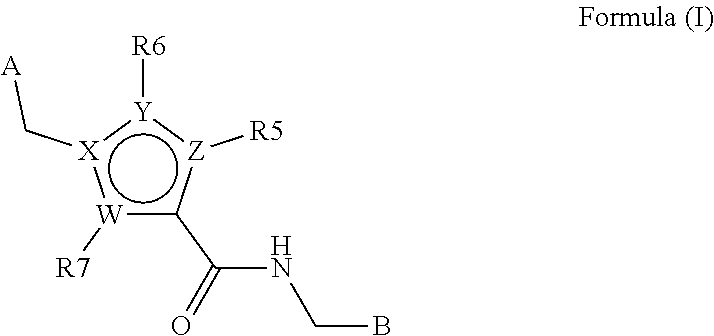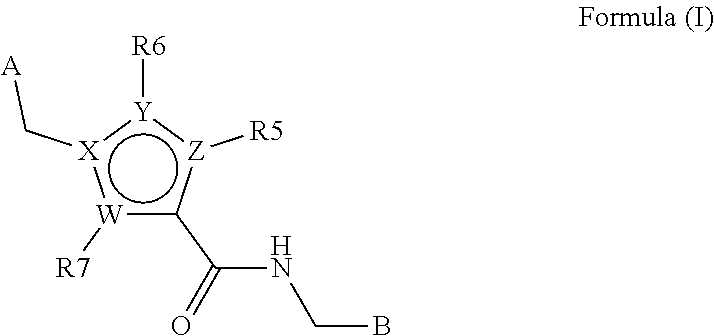Heterocyclic derivates
a derivative and heterocyclic technology, applied in the field of inhibitors of plasma kallikrein and retinal vascular permeability, can solve the problems of limited molecule description, abnormal abundance of plasma kallikrein-kinin system, and no small molecule synthetic plasma kallikrein inhibitor has been approved for medical use, etc., to achieve good pharmacokinetic profile and reduce retinal vascular permeability
- Summary
- Abstract
- Description
- Claims
- Application Information
AI Technical Summary
Benefits of technology
Problems solved by technology
Method used
Image
Examples
example 1
2,5-Dimethyl-1-(2-phenyl-thiazol-4-ylmethyl)-1H-pyrrole-3-carboxylic acid (1-amino-isoquinolin-6-ylmethyl)-amide
[0349]
A. 2-Acetyl-4-oxo-pentanoic acid ethyl ester
[0350]Ethylacetoacetate sodium salt (17.10 g, 112 mmol) was suspended in acetone (500 mL). Potassium carbonate (15.54 g, 112 mmol) and potassium iodide (3.73 g, 22.48 mmol) were added and the resulting solution was refluxed. Chloroacetone (11.41 g, 124 mmol) was added dropwise over a period of 5 min. Once the addition was complete the mixture was heated under reflux for a further 2 hrs. The reaction mixture was allowed to cool to rt and the solid material was filtered off and washed with acetone. The resultant filtrate was evaporated and purified by flash chromatography (silica), eluent 75% Pet. Ether, 25% EtOAc, fractions combined and evaporated in vacuo to give a yellow oil identified as 2-acetyl-4-oxo-pentanoic acid ethyl ester (10.1 g, 54.2 mmol, 48% yield).
B. 1-[2-phenyl)-thiazol-4-ylmethyl]-2,5-dimethyl-1H-pyrrole-3-c...
example 2
2,5-Dimethyl-1-(2-phenyl-thiazol-4-ylmethyl)-1H-pyrrole-3-carboxylic acid (1-amino-isoquinolin-7-ylmethyl)-amide
[0368]
A. 2,5-Dimethyl-1-(2-phenyl-thiazol-4-ylmethyl)-1H-pyrrole-3-carboxylic acid (1-amino-isoquinolin-7-ylmethyl)-amide
[0369]2,5-Dimethyl-1-(2-phenyl-thiazol-4-ylmethyl)-1H-pyrrole-3-carboxylic acid (93 mg, 0.30 mmol) was dissolved in CH2Cl2 (15 mL). This solution was cooled to 0° C. 7-Aminomethyl-isoquinolin-1-ylamine hydrochloride (C. A. A. Van Boeckel et al., WO 98 / 47876) (56 mg, 0.33 mmol) was added followed by HOBt (48 mg, 0.32 mmol) and triethylamine (211 mg, 2.1 mmol). Water soluble carbodiimide (80 mg, 0.42 mmol) was then added. After 18 hrs at 0° C. to rt reaction mixture was diluted with chloroform (200 mL) and washed with NaHCO3 (1×50 mL), water (1×50 mL), brine (1×50 mL), dried (Na2SO4) and evaporated in vacuo. The residue was purified by flash chromatography (silica), eluent dichloromethane:MeOH:NH3 (100:10:1), fractions combined and evaporated in vacuo to g...
example 3
2,5-Dimethyl-1-(2-phenyl-thiazol-4-ylmethyl)-1H-pyrrole-3-carboxylic acid (1H-pyrrolo[2,3-b]pyridin-5-ylmethyl)-amide
[0372]
A. 2,5-Dimethyl-1-(2-phenyl-thiazol-4-ylmethyl)-1H-pyrrole-3-carboxylic acid (1H-pyrrolo[2,3-b]pyridin-5-ylmethyl)-amide
[0373]2,5-Dimethyl-1-(2-phenyl-thiazol-4-ylmethyl)-1H-pyrrole-3-carboxylic acid (120 mg, 0.38 mmol) was dissolved in CH2Cl2 (20 mL) and DMF (2 mL). This solution was cooled to 0° C. 5-Aminomethyl-7-azaindole hydrochloride (57 mg, 0.38 mmol), HOBt (62 mg, 0.41 mmol) and triethylamine (192 mg, 1.92 mmol). and water soluble carbodiimide (104 mg, 0.54 mmol) were then added. After 18 hrs at 0° C. to rt reaction mixture was diluted with chloroform (100 mL) and washed with NaHCO3 (1×30 mL), water (1×50 mL), brine (1×30 mL), dried (Na2SO4) and evaporated in vacuo. The residue was purified by flash chromatography (silica), eluent 4% MeOH, 96% dichloromethane, fractions combined and evaporated in vacuo to give a white solid identified as 2,5-dimethyl-1-(...
PUM
 Login to View More
Login to View More Abstract
Description
Claims
Application Information
 Login to View More
Login to View More - R&D
- Intellectual Property
- Life Sciences
- Materials
- Tech Scout
- Unparalleled Data Quality
- Higher Quality Content
- 60% Fewer Hallucinations
Browse by: Latest US Patents, China's latest patents, Technical Efficacy Thesaurus, Application Domain, Technology Topic, Popular Technical Reports.
© 2025 PatSnap. All rights reserved.Legal|Privacy policy|Modern Slavery Act Transparency Statement|Sitemap|About US| Contact US: help@patsnap.com



